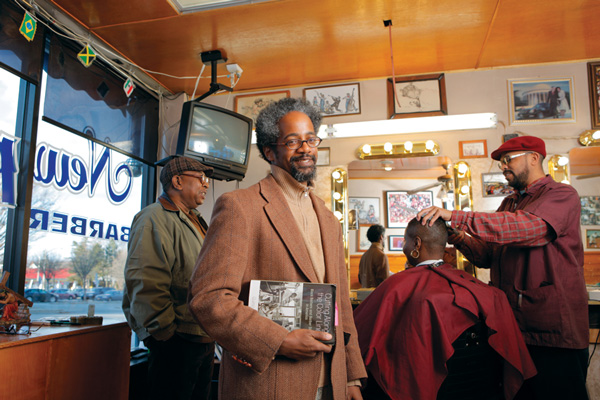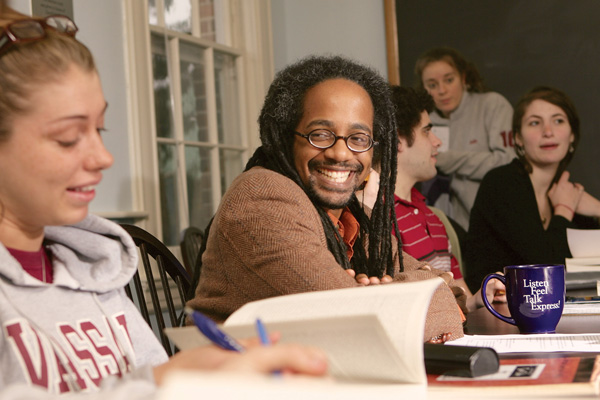A Cutting Narrative

Imagine: It’s 1839, and you’re a free black man traveling through Newburgh, NY, about 20 miles south of Poughkeepsie. You are in a state that abolished slavery 11 years earlier, but you walk into a black-owned barber shop to get your hair cut and the proprietor bluntly tells you he doesn’t serve “coloreds.”
To appreciate this actual occurrence in its time and place, Associate Professor of History Quincy Mills knows you must step out of the customer’s shoes and into those of the businessman. In so doing you enter the illuminating world of African American barbers—which Mills explores in his new book Cutting Along the Color Line: Black Barbers and Barber Shops in America (University of Pennsylvania Press, 2013). In it, he reveals invaluable and often unexpected insights about the intersection of commerce, entrepreneurship, race identity, and race relations for African Americans since the 19th century.
Slavery in the U.S. and its shifting impacts and legacies are constant and key forces at work in the history that Mills analyzes. A scholar of African American history from both business and social perspectives (he earned an MBA and a PhD in history), he establishes early in his book that, “Self-sufficiency has been a key component of the meanings of black freedom since slavery. Barber shops have historically been one of the most accessible paths to business ownership and economic independence.”
Mills’s case study about the black barber refusing black customers sheds light on the economic necessities these entrepreneurs faced and the choices required for their success. Barbering had been among the services that slaveholders and other wealthy whites entrusted to enslaved black men. Mills notes that, as free black men skilled in barbering sought to emerge from slavery as self-reliant businessmen, they quickly realized they would have to cultivate an elite white clientele, patrons that refused to be barbered in the same establishment as black customers.
“Black barbers wanted to retain their wealthy customer base, so they essentially chose sales over solidarity,” says Mills.
As he writes in Cutting Along the Color Line: “Their business decisions did not go unnoticed among black communities across the country. In the period between the end of the Civil War and the turn of the century, black barbers carefully calibrated the social costs and the financial benefits of grooming exclusively the white elite.”
Through the numerous small stories Mills shares in his book, he weaves together many nuances of African American history, politics, culture, and commerce to yield an even more powerful historical impact.
Consider Uriah Boston, a 19th-century Poughkeepsie barber, abolitionist, and black suffrage leader who found himself in a public scrape with fellow abolitionist and social reformer Frederick Douglass. Mills writes: “Douglass reasoned that barbering may have been one of the preferred occupations during slavery, but in freedom, black barbers embraced a false sense of economic security. Douglass envisioned the mechanical arts, or ‘high industry,’ as the path to black economic elevation and respectable citizenship.”
Douglass shared these views—along with a broader critique about blacks’ overreliance on service professions—with such fellow black activists as Martin Delany and David Walker, and he made his beliefs well known from the bully pulpit of the Frederick Douglass’ Paper.

“Many readers wrote to the paper in support of Douglass’s charge that in order to operate on equal footing with white citizens, black barbers, cooks, and waiters need to stop serving them,” recounts Mills in his book. Boston wrote in defense of his profession, pointing out that barbers constituted “a very large class of business men among our people.”
Last fall, at a public reading hosted by the Mid-Hudson Heritage Center at 317 Main Street in downtown Poughkeepsie—the same address where Boston had his shop—Mills pointed out that Douglass’s attitude about black barbers would undoubtedly have been more favorable if the barbers were taking black customers.
When Mills began what proved to be his 13-year journey from research to publication (he jokes that three of his children were born while the book was gestating), he had no idea that black barbers had been a flashpoint for 19th-century African Americans’ debate about economic uplift, social identity, and race loyalty. His curiosity was first piqued while working on an ethnography of the Truth and Soul barber shop on the South Side of Chicago, for Melissa Harris-Perry’s acclaimed book Barbershops, Bibles, and BET: Everyday Talk and Black Political Thought (Princeton University Press, 2006).
“It got me wondering if black barber shops had always been these kind of bustling spaces of conversation and economic activity in black communities. What would a black-owned barber shop look like in 1940 or 1840?” Mills muses.
Childhood memories of time spent in his grandfather’s South Side Chicago barber shop fueled his interest as well. “The moments I remember most vividly are those when he had no customers and sat in his barber’s chair talking with a fellow barber or other men in the shop,” writes Mills. “I selectively forget the buzzing in my ear from the clippers that unnerved me when he cut my hair.”
While in 1840 black-owned barber shops served only white patrons, by 1940 these enclaves were known as gathering places for black men. “Eddie,” the elder barber (played by Cedric the Entertainer) in the popular 2002 movie Barbershop, declared these shops “the place where a black man means something, the cornerstone of the neighborhood, the black man’s country club.” How did this quantum leap occur in roughly a century?
Among a variety of developments, Mills points to two that converged toward the close of the 19th century. One was an infusion of white men into barbering—both newly arrived white immigrants hungry for whatever work they could find, and “native” whites. “They competed with black barbers for those wealthy white patrons in downtown America by attempting to ‘professionalize’ the trade,” Mills explains. For example, white barbers were leading organizers of the Journeymen Barbers’ International Union of America, which lobbied state legislatures to pass licensing laws which, among other things, required barbers to attend a barber’s college, many of which would not admit blacks.

The second significant change was prompted by the rise of Jim Crow, and came in the attitudes of black barbers born after the Civil War. “They were much less connected and interested in opening shops for white men. Instead, they opened their shops in black communities,” Mills explains. “It would be a mistake to assume that Jim Crow forced them out of downtown districts, though we cannot argue with the power of discrimination. Yet, this new generation of black barbers frankly had different ideas of how a modern black barber shop should be organized.”
As more black barbers sought business among their peers, Mills writes, they grew collectively to embrace a new defining principle: “Grooming black men was a way of creating a respectable black masculinity.” Moreover, he writes, “For the set of barbers I was looking to interview, a neatly groomed face and head could be the difference in getting a job or getting a date.”
Mills sought out barbers for oral history interviews in such locales as Cleveland, Philadelphia, Richmond, Atlanta, and Durham. These men represented the post–Civil War generation of barbers, and by that time were in their 70s or 80s. Many of them, especially in the South, provided Mills quite a reality check when he initially introduced himself and his project wearing his hair in dreadlocks.
Mills recalls a barber saying, “I’m in the grooming business, and you don’t look groomed.” Another asked, “What does it mean that you’re here to talk to me about barbering, but you haven’t cut your hair in I don’t know how long?” Mills also remembers hearing, “If we were depending on people like you, we would be out of business.” He had a much easier time talking to southern barbers after he cut his hair.
Noted historian and history department colleague James Merrell calls Cutting Along the Color Line “a work of unusual breadth for any book, but especially for a first book. Quincy was working on a very ambitious canvas. He expanded across a huge terrain chronologically as well as geographically.
“I was impressed to the point of awestruck by how he wove all of this material together, and yet he had done so without losing track of the individuals,” he notes. “Sometimes in these grand sweeping stories, the personal stories can get lost in the sweep.”
It should come as no surprise that Mills brings history’s smaller personal stories—including his own—to life in the classroom. “What stands out is the way he combines ‘teaching the facts’ with his personal experience and knowledge,” explains senior Katharine George, an urban studies major who assisted Mills with research for his book.
History major Adam Murphy ’10 was particularly shaped by Mills’s prowess and dedication as a thesis adviser. Now at the Center for Appellate Litigation, a Manhattan-based public defender’s office that advocates for indigent criminal defendants, Murphy examined, as part of his thesis, a major study that demonstrated racial discrimination in Georgia’s application of the death penalty. He recalls, “I was having a difficult time understanding the statistics and methodology behind the Baldus study. [Quincy] read through the study, which was quite dense and lengthy, and then explained its statistical implications in a very straightforward and practical way.”
Mills also urged Murphy to observe the Vassar tradition of “going to the source,” to record an interview with leading civil rights attorney John Charles Boger, who had argued a relevant case before the U.S. Supreme Court. “He also pushed me to take trips to the Supreme Court and to the Library of Congress to find rich primary resources in the manuscript divisions,” Murphy reports.
Murphy says the commitment to dig deeper, instilled by faculty members like Mills, has been invaluable. “Often a case turns on our office’s investigative research. And in criminal defense work, almost every document is a primary source,” he reports.
Like Murphy, Mills acknowledges a special debt to an undergraduate history professor—though in Mills’s case she steered him in an unexpected direction as he was completing a bachelor’s degree in business at the University of Illinois. “Like many students of color, I had planned to enter a field with markers of success and mobility, like business, medicine, or law,” Mills explains. “Yet, the study of history served as an intriguing interest that occupied many of my electives.”
That interest proved so strong that in his senior year Mills did a thesis-length independent research projectwith history professor Juliet E.K. Walker (now at the University of Texas at Austin) on the all-black town of Mound Bayou, Mississippi. The piece won both a campus essay competition and a national award. Professor Walker encouraged him to consider history as a profession.
Today, Mills completes the mentoring circle with students such as Murphy, who declares, “Quincy pushes his students to be the best, most thorough versions of themselves.”
